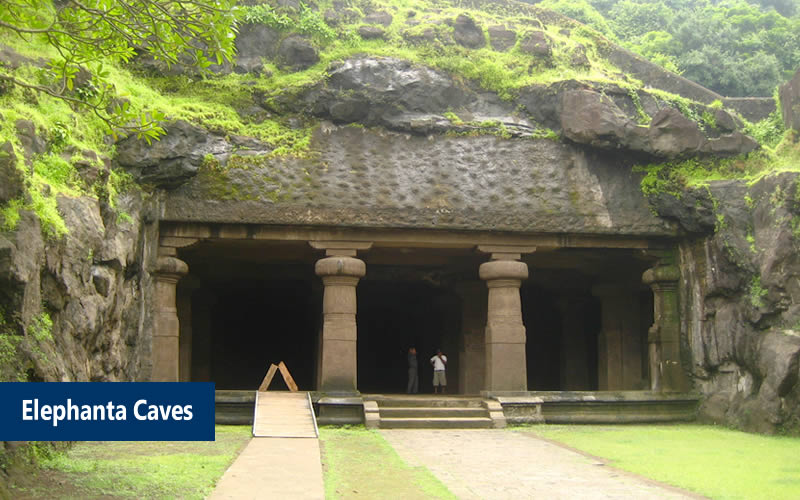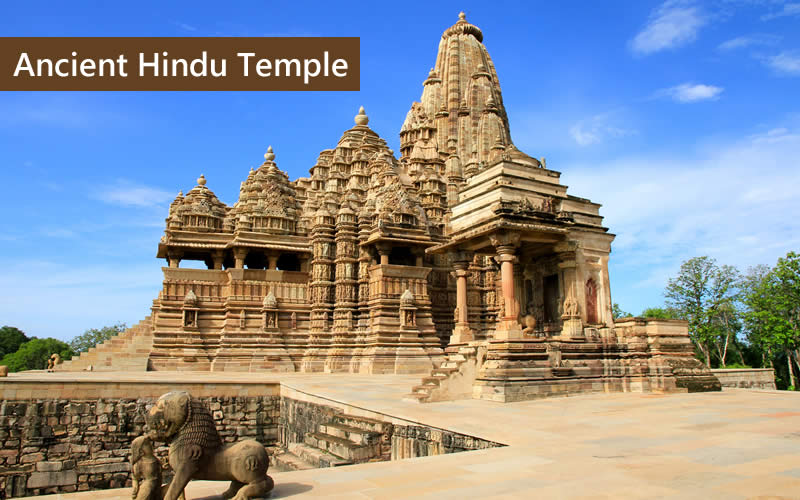MIDDLE INDIA
- Day 01: Arrive Mumbai
- Day 02: Mumbai / Pune
- Day 03: Pune / Aurangabad
- Day 04: Aurangabad
- Day 05: Aurangabad / Jalgaon
- Day 06: Jalgaon / Indore
- Day 07: Indore
- Day 08: Indore / Ujjain / Bhopal
- Day 09: Bhopal
- Day 10: Bhopal / Orchha
- Day 11: Orchha / Gwalior / Agra
- Day 12: Agra
- Day 13: Agra / Delhi
- Day 14: Delhi / Europe
Tour Highlights:
- Elephanta Caves
- Ellora Caves
- Pitalkhora Caves
- Ancient Hindu Temples
- Mahakaleshwar Temple
- Ashoka Pillar
Tour Schedule - MIDDLE INDIA
DAY 01:: ARRIVE MUMBAI
- Arrive Mumbai by flight LH 756 at 0135 Hrs. ( Rooms to be protected for immediate occupancy)
- On arrival you will be welcomed with garlands at the airport and transferred to the hotel Taj Mahal.
- Bombay, or Mumbai, is the capital of Maharashtra and the economic powerhouse of India. It’s the fastest moving, most affluent and the most industrialized city in India.
- Yet, once upon a time, Bombay was nothing more than a group of low-lying, swampy and malaria mud flats presented to the British by its Portuguese occupiers as a wedding gift in 1661.
- Dinner and overnight at the hotel
.DAY 02:: MUMBAI / PUNE
- Breakfast at hotel.Morning sightseeing of Mumbai city and Elephanta caves.
- Elephanta Caves. The island of Elephanta is an hour away from Mumbai by motor launch.
- The cave temples here were excavated between the 5th and 8th centuries AD are famous for their magnificently sculpted panels.
- The best known is the one that depicts the Mahesh Murti – a three – headed image of Lord Shiva, which signifies the creator, preserver and destroyer of this universe as per Hindu mythology.
- The Portuguese named this island after a large stone elephant that was found near the landing. The elephant now stands at the Victoria and Albert Museum on the mainland.
- Later drive to Pune.
- Arrive Pune and check in hotel Royal Le Meridien.
- Dinner and overnight at hotel.
DAY 03:: PUNE / AURANGABAD
- Breakfast at the hotel.
- Early morning drive to Aurangabad.
- AURANGABAD
The city of Aurangabad was founded by Malik Ambar in 1610.It received its current name in 1653 when Aurangzeb made it the capital of the Deccan. It has seen several dynasties come and go, absorbing the culture of each into itself. Historic towns like Khuldabad, Pitalkore and Paithan lie scattered a few kilometres away.Aurangabad also has a 50,000 year old meteorite impact crater which has remained a lesser known discovery. - Afternoon sightseeing of Ellora. Ellora Caves of Ellora, another World Heritage site, are carved into the side of a basaltic hill 30 km from Aurangabad. The finest specimens of cave-temple architecture, they encompass 34 rock-cut shrines representing Buddhist, Jain and Hindu art dating from the 4th to 5th century AD. The 12 caves to the south are Buddhist, the 17 in the centre Hindu, and the 5 caves to the north are Jain. The most remarkable is the Kailash temple, meant to be a replica of Shiva’s celestial abode Mt.Kailash. It is the best example of rock cut architecture and an engineering marvel.
- Dinner and overnight at the hotel.
DAY 04:: AURANGABAD
- Breakfast at the hotel.
- Morning sight seeing at Aurangabad caves.
- The Aurangabad caves are 12 artificial rock-cut Buddhist shrines located on a hill running roughly east to west, nearly 2 km north from Bibi Ka Maqbara in Aurangabad, Maharashtra. The first reference of Aurangabad Caves is cited in the big Chaitya of Kanheri. The Aurangabad Caves were dug out of comparatively soft basalt rock during the 6th and 7th century. Caves are divided into three separate groups depending on their location. Sculptural carvings of Aurangabad Caves reached belong to highest achievements of Indian classical art and can be compared to the best paintings of Ajanta.
- Afternoon visit the Pitalkhora Caves.
- Pitalkhora Caves: Pitalkhora in the Sastamala range of the Sahyadri hills are of great interest. There are thirteen caves, set high up on the hill, overlooking picturesque ravines. Many of the caves have crumbled and are badly damaged. Because of its remoteness Pitalkhora has few visitors.
- Pitalkhora Caves, which dates back to 2nd century BC are only 40 km away from Ellora caves at Aurangabad. One can see here many unusual sculptures like Yaksa figures.
- The main gate has a wide terrace, with the naga and guardians flanking the door, and a row of elephants decorate the complex. A stair directly connects the entrance to the chaitya. A group of viharas, a chaitya hall, and two smaller caves across the gorge with stupas consist the complex.
- Dinner and overnight at the hotel.
DAY 05 :: AURANGABAD / JALGAON
- Breakfast at the hotel.
- Morning visit the Ajanta caves
- Ajanta Caves
The Buddhist caves of Ajanta lying 105 km northeast of Aurangabad date from 200 BC to 650 AD. The 30 rock-hewn caves are adorned with sculptures and frescoes, portraying in epic form the religious and secular life through eight centuries. Many of the caves house panels depicting stories from the Jatakas, depicting Buddha’s previous births. It is a World Heritage site. - Later drive to Jalgaon.
- Arrive Jalgaon and check in hotel Mahendra Resort.
- Dinner and overnight at hotel.
DAY 06:: JALGAON / INDORE
- Breakfast at hotel.
- Later drive to Indore.
- Indore is called the “mini Mumbai” of India. A town that has seen rapid growth in the last 10 years.
- It is an important business and industrial center. Areas like Pitampura, the third largest industrial belt in Asia, and Dewas, where major factories such as those of the Tatas, Kirloskars, S. Kumars, Ranbaxy and others are located. In Pitampura are Hindustan Motors, Bajaj, Indo Rama Synthetics, Eicher and other heavy and light automobile industries. Apart from its industrial importance, Indore is the gateway to Ujjain and Omkareshwar, both having ancient Hindu temples.
- The importance of Indore as a growing city can be assured by the fact that the airlines have started flying into the city recently. Large-scale work is being carried out at Indore airport.
- Dinner and overnight at hotel.
DAY 07:: INDORE
- Breakfast at hotel.
- Full day excursion to Mandu. Mandu 95 kms away, is an important center of architecture. A former royal city, it is rich in monuments built around water tanks. In the monsoon, Mandu’s magic is spellbinding. The architecture in Mandu is predominantly in the Indo-Islamic style, right from Dilawar Khan’s period till the Mughal rule. The fort continued to be ruled by Mughals till the early part of 18th century when it passed into the hands of the Marathas in 1732 after the Mughal hold weakened when the capital of Malwa was shifted back to Dhar and Mandu became a ghost town.
- Despite being abandoned for the past four centuries, there is enough romance in the ruins to capture the imagination of the visitor.
- Visit the Ashrafi Mahal,Jama Masjid, Hoshang Shah, Ship Palace, Hindola Mahal
Dinner and overnight at hotel Fortune landmark.
DAY 08:: INDORE / UJJAIN/BHOPAL
- Breakfast at hotel. Later drive to Bhopal enroute visiting Mahakaleshwar Temple at Ujjain.
- Mahakaleshwar Jyotirlinga is one of the most famous Hindu temples dedicated to Lord Shiva and is one of the twelve Jyotirlingas (It is believed that Lord Shiva first manifested himself as a Jyotirlinga, thus the special reverence for the Jyotirlinga. There is nothing to distinguish the appearance, but it is believed that a person can see these lingas as columns of fire piercing through the earth after he reaches a higher level of spiritual attainment.)which are supposed to be the most sacred abodes of Shiva. It is located in the ancient city of Ujjain in the state of Madhya Pradesh, India. The temple is situated on the side of the Rudra Sagar lake. The presiding deity, Shiva in the lingam form is believed to be Swayambhu (means Self-manifested or that which is created by its own accord), deriving currents of power (Shakti) from within itself as against the other images and lingams that are ritually established and invested with mantra-shakti.
- Arrive Bhopal and check in hotel Noor Us Sabah.
- Bhopal
Madhya Pradesh has an illustrious past, forested sanctuaries, temple towns and fortified settlements. Bhopal, its capital, a modern city with two lakes, is situated against the background of hills that give it a salubrious climate. Bhopal is growing because of its pleasant climate and, in recent years, has staked its claim on the country’s industrial map with the growth of two industrial towns in its precincts, Mandideep (18 km) and Govindpura (9 km). - Bhopal was the only principality ruled by noblewomen for long periods, who contributed to the city’s architecture, more notably its mosques.
- Dinner and overnight at hotel.
DAY 09:: BHOPAL
- Breakfast at hotel.
- Morning visit Sanchi : 46 Kms North of Bhopal. Sanchi is an unmatched repository of Buddhist art and architecture in India located on a secluded hill crowned by a group of stupas, chaityas, temples, pillars, monasteries and gateways are embellished by the most delicate carvings depicting incidents of Buddha’s life and his teachings. The famous great stupa was built by Emperor Ashoka in the 3rd century B.C. famous for its magnificent carved gateways or toranas.
- Other attractions includes, the Ashoka Pillar built in 3rdd century B.C. The Gupta Temple built in 5th century A.D. and the Archaeological Museum displaying antiquities, excavations at Sanchi, the lion capital of Ashoka. Afternoon Take a tour of Bhopal visiting the Taj-ul-Masjid, the largest masque in India, the Jama Masjid, the Moti Masjid, the Shaukat Mahal, the Sadar Manzil, the Bharat Bhawan, the Chowk, lined with mosques, the Upper & Lower Lakes, the Shamla & Idgah Hills.
- Dinner and overnight at hotel.
DAY 10:: BHOPAL / ORCHHA
- Breakfast at hotel.
- Early Morning visit Bhojpur: Just 40 Kms from Bhopal, famous for its 11th century Shiva Temple, the abode of probably the largest single stone “Shiva Lingam” in the world. The temple and the lake built by Raja Bhoj Paramara is known as the Somnath of North India.
- The temple has many exquisite Shiva images, engravings on its walls, on rocks, very well preserved by Archeological Survey of India, every tourists delight is Bhojpur.
- Later transfer to Railway Station to board Shatabdi Express at 1747 Hrs.for Jhansi and then drive to Orchha
- Arrive Orchha and check in hotel Orchha Resort.
- Orchha is a medieval city founded by the Bundela rulers with palaces and temples of the 16th and the 17th century which have remarkably withstood the onslaught of time. The city is picturesquely flanked by the river Betwa. Head for the ruins of the fort of Orchha among whose palaces & temples count the Raj Mahal Palace & the temple of Lakshminarayan.
- Dinner and overnight at hotel.
.DAY 11:: ORCHHA / GWALIOR/AGRA
- Breakfast at hotel.
- Later drive to Gwalior.
Visit the Gwalior Fort with its temples and palaces. Also, take a tour of the Jai Vilas palace and Museum inhabited by the present Maharajah. - Later transfer to Railway Station to Board Shatabdi Express at 1900 Hrs for Agra.
- Arrive Agra at 2010 Hrs and transfer to hotel Taj View.
- Agra
Agra lies to the southeast of Delhi and is home to the world-famous Taj Mahal. Agra rose to its fame in the medieval period as the capital of the Mughal Empire and it was beautified with gardens, waterfalls, bathhouses and canals. - In the modern times, the city of Agra is a thriving carpet industry where you can also find leather workers, sandstone and marble sculptors, some of whom claim to be direct descendants of the craftsmen who had helped build the Taj Mahal.
- Dinner and overnight at hotel.
DAY 12:: AGRA
- Breakfast at hotel.
- Agra was the capital of the Mughal dynasty. The strength of the dynasty is visible in the huge forts and monuments that have been built by them. A small city but has witnessed the rise and the fall of the empire. It was build by Akbar the great and remained the capital till it was shifted to Delhi. Attracting the maximum number of tourists is the city of the Taj Mahal. The over 300 year-old white marble Taj is the main draw along with the various monuments and historical sites dating back to the Mughal period.
- Morning visit Agra Fort. Construction of Agra Fort was begun by Emperor Akbar in 1565, and additions were made up until the time of his grandson, Shah Jahan.
- While in Akbar’s time the Fort was principally a military structure, by shah Jahan’s time it had become partially a palace. There are many fascinating buildings inside the massive walls, which stretch for 2½ Kms surrounded by a moat over 10 meters wide. The Fort is at the bank of river Yamuna and overlooks Taj Mahal.
- Latter visit Itmad Ud Daulah “a jewel box in a marble”. This mausoleum was built by the empress Nur Jahan as a gesture of love for her father. The tomb is built of the finest Indian marble embellished with mosaics and beautiful inlay work of semi precious stones. The central chamber contains the yellow marble tomb of Itmad-ud-Daulah and his wife. The tomb is painted with floral decorations and fine marble screens of geometric latticework suffuse the interior in a soft light.
- Afternoon visit Taj Mahal at Sun Set (closed on Friday) was built in 1630 by Mughal Emperor Shah Jahan in memory of his deceased wife Mumtaz Mahal to enshrine her mortal remains. The monument has been described as the most extravagant ever built for love, for the emperor was heart-broken when Mumtaz, to whom he had been married for 17 years, died in 1629 in childbirth soon after delivering her 14th child.
- Dinner and overnight at the hotel.
DAY 13:: AGRA / DELHI
- Breakfast at hotel.
- Early morning drive to Delhi.
- Arrive Delhi and transfer to hotel.
- There have been at least eight cities built over the millennia around modern New Delhi, the capital of India. Standing on the west bank of the Yamuna river at the narrowest point between the Aravali hills and the Himalaya, for over 2,000 years Delhi has commanded the strategically vital route from the Northwest frontier to the agriculturally rich Ganga plains. Former Sultans have left their lasting mark in the Qutab Minar complex, while Old Delhi, Emperor Shah Jahan’s 17th century capital, retains a flavor of its atmospheric past.
- Afternoon proceed on a combined sightseeing tour of the city, visiting both Old and New Delhi. In Old Delhi, you will visit the magnificent Jama Masjid – one of the largest mosques in India and the last great architectural work of Shah Jahan, intended to dwarf all mosques that had gone before it. Later drive past Red Fort. Also visit Raj Ghat – the cremation sights of Mahatma Gandhi & Jawaharlal Nehru. Also have a short cycle rickshaw ride tour through Chandni chowk.
- Proceed to Qutab Minar complex. The work of Qutab Minar was begun on 1199 and was to be the prototype of all minors in India. It was intended to be the most glorious tower of victory in the world.
- Proceed to Humayun’s Tomb – the best example in Delhi of the early Mughal style of tomb. Her widow Haji Begum built this tomb. Then visit Laxmi Narayan Temple – a modern Hindu temple. New Delhi whose colonial architecture evokes the bygone days of the British empire.
- Drive past Rashtrapati Bhawan – President’s House, Parliament and Secretarial buildings.
- Dinner and overnight at hotel.
DAY 14:: DELHI / EUROPE
- Breakfast at the hotel.
- In time transfer to airport for flight to ITALY.
*Note: All flight details and timings are subject to change.









